|
 Mycena morris-jonesii Mycena morris-jonesii
SynonymsGalactopus morris-jonesii
BiostatusPresent in region - Indigenous. Endemic
Images (click to enlarge)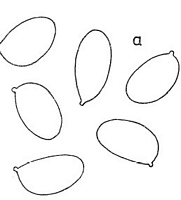
Caption: 179-Galactopus morris-jonesii: a. spores; b. cheilocystidia. | 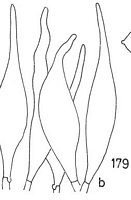
Caption: 179-Galactopus morris-jonesii: a. spores; b. cheilocystidia. | 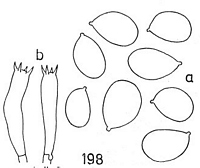
Caption: 198-Galactopus morris-jonesii: a. spores; b. basidia. | 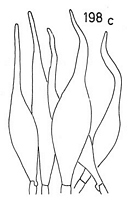
Caption: 198-Galactopus morris-jonesii: c. cheilocystidia. | 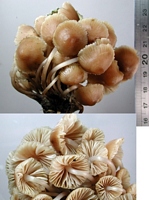
Owner: J.A. Cooper | 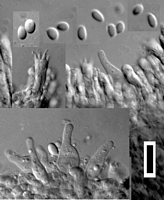
Caption: basidia, cheilocystidia and spores. Scale = 20um
Owner: J.A. Cooper | 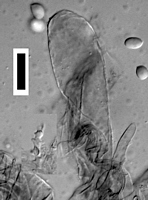
Caption: vesiculose cap cells and smaller diverticulate hyphae. Scale = 20um.
Owner: J.A. Cooper | 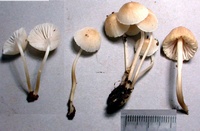
Owner: P. Leonard | 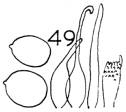 | 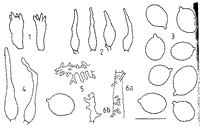
Caption: Fig.11 M. morris-jonesii. 1. basidia. 2. cheilocystidia. 3. basidiospores. 4. pleurocystidia. 5. pileipellis elements. 6a. caulocystidia. 6b. terminal cells of stipe (PDD 34878). |
Article: Horak, E. (1971). A contribution towards the revision of the Agaricales (Fungi) from New Zealand. New Zealand Journal of Botany 9(3): 403-462 (http://www.rsnz.org/publish/abstracts.php).
Description: Mycena morris-jonesii Stevenson (29 D) Figs 16, 17 = Galactopus morris-jonesii (Stevenson)
comb. nov. (Basionym: M. morris-jonesii Stevenson, Kew
Bull. 19: 52, 1964)
Spores oval, hyaline, amyloid, smooth, 7.5-9 X 4.5-6 µ. Cheilo- and
pleurocystidia fusoid or awl-shaped, thin-walled, coloured with a reddish
plasmatic pigment, 50-70 X 10-15 µ.
Article: Segedin, B.P. (1991). Studies in the Agaricales of New Zealand: some Mycena species in sections Longisetae, Polyadelpha, Rubromarginatae, Galactopoda, Lactipedes, and Calodontes. New Zealand Journal of Botany 29(1): 43-62 (http://www.rsnz.org/publish/abstracts.php).
Description: Microscopic characters of the holotype Spores 8-9.5 X 6.5-7.5 (8.6 X 6.8) µm,
Q=1.26, 30-35 X 4-8 µm, narrowly fusiform-ventricose to lageniform and often
geniculate between the neck and the ventricose portion, forming a fairly dense,
tangled layer. Pleurocystidia slightly larger with longer necks than the cheilocystidia.
Basidia short and fat with short, fat sterigmata. Trama of more or less parallel
hyphae 12-15µm diam., with broad lactifers with yellowish (in KOH) contents,
not dextrinoid. Pileipellis of repent hyphae about 3-3.5 µm diam. with short,
simple or once-bifurcated, colourless outgrowths. Context of greatly inflated
cells (-80 µm diam.) and numerous, conspicuous lactifers with shining, bright
golden (in KOH) contents. Subpellis of slightly gelatinised hyphae. Stipe of
parallel hyphae, with very conspicuous lactifers with yellow oily contents:
the cortical cells are covered with small, simple or once-bifurcated, colourless
outgrowths, with occasional terminal cells 10-15 X 2-3 µm, with small protuberances.
This is a very tough fungus and sections of the basidiome
are very difficult to squash after KOH treatment. The basidiomes are light brown
in colour when dried and have a very distinct, small umbo.
Description of basidiome based on information from a further collection
Pileus variable in size from 6-25 mm diam., convex conic
with a distinctly pointed umbo, fawn to umber or bay brown at the centre, pellucid
striate at the margin, smooth, drying yellow-brown. Lamellae creamy white, drying
light yellow-brown, fairly broad, slightly decurrent, in 3 series, margin fimbriate
under a lens, not differently coloured. Stipe 20-70 X 2-3 mm, smooth, pale yellow-brown
at the top, darker below, even for most of length but slightly expanded at the
base. Taste and smell unknown. Basidiome dries light brown with yellowish stipe.
Microscopically
PDD 34878 varies little from the type. Spore range, 7-10 X 4.5-7(8.6 X 6.4)
µm, Q=1.3, is similar. Some cheilocystidia and pleurocystidia are slightly larger,
the pleurocystidia being the larger of the two; both are commonly geniculate
at the base of the neck and some at the base of the cystidium. A few very small,
slightly diverticulate elements were found on the stipe (Fig. 9,6b).
Habitat: HABITAT: among moss and litter in mixed podocarp-dicotyledonous
forest.
Notes: It is unfortunate
that no fresh collections of this fungus have been made recently to complement
the above description, which is derived from dried material. Stevenson apparently
did not see the lactifers in her material and the presence of the many tiny
outgrowths from pileipellis and stipe elements persuaded her to classify this
fungus in section Rigidipes, subsection Ciliatae. There does not seem any doubt,
however, that this fungus should be classified in section Lactipedes.
Article: Stevenson, G. (1964). The Agaricales of New Zealand: V. Kew Bulletin 19(1): 1-59.
Description: Pileus 2-2.5 cm. diam., fawn with brown striations, bay brown at centre, campanulate, umbonate; flesh thin, white to fawn, fragile. Gills sinuately adnexed, creamy white, distant. Stipe 6-7 cm. x 2-3 mm, pale fawn above, bay brown at base, smooth, hollow, fragile. Spores 8 x 6-7 µm, amyloid, thin-walled. Hymenophoral trama and pileus tissue pseudo-amyloid. Cheilo- and pleurocystidia 25-45 x 5-8 µm, more or less awl-shaped; gill margin somewhat gelatinized (Fig. 49).
Habitat: In forest litter, Gollan's Valley. Wellington. 20.5.1949, A. Morris-Jones in Stevenson (type).
|